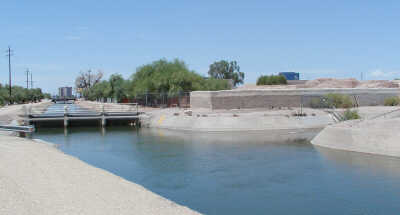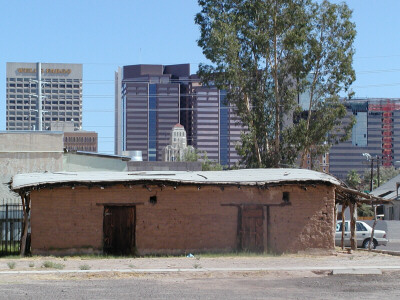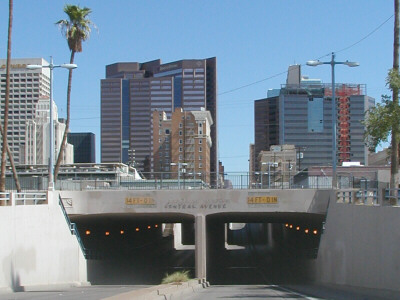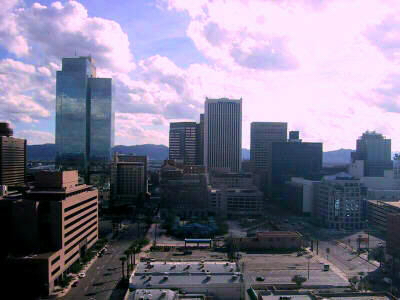|
What do Phoenix, Arizona and
Jamestown, Virginia--the first permanent English settlement in
America--have in common? John Smith was instrumental in the
establishment of both towns. More precisely, a John
Smith helped establish each town. Our John Smith was a
Lieutenant in the U.S. Army at Fort McDowell, which was established
258 years after Jamestown's settlement in 1607. When
Lieutenant Smith mustered out of the Army not long after the fort
was opened, he decided to stay in the valley and sell hay to the
post. He located what was to become know as "Smiths
Station" eighteen miles south of the fort, near present day
40th Street and Washington. It was there in the flood plain of
the Salt River that he had seen wild hay growing.
In 1867 Smiths Station was visited by a gregarious redheaded
adventurer named Jack Swilling. Swilling, then thirty-seven,
had been an Indian fighter, Union scout, Confederate officer, and
gold prospector. His project this time was to clean out some
of the ancient canals built by the Hohokam Indians and bring water
from the Salt River to the dry valley land. Between 700 A.D.
and 1100 A.D., the Hohokams had engineered an
extensive network of canals to grow barley, cotton, and other crops
in the desert.PH1
With $400 raised from investors and an initial labor force of 16,
the Swilling Irrigation Canal Company cleared a ditch running from
the Salt River near present day 40th Street, north to Van Buren, and
west to around 27th Avenue.
By 1870, the federal census gave the valley a population of 164
men and 61 women, all between the ages of twenty-one and thirty.
It was time that an official town site be selected. In
October, the valley citizens met to select some public land for a
town. The site eventually selected was on the North bank of
the Salt River. The first lot, at the corner of Washington and
Montezuma (now First Street), sold for $104 in December, 1870.
A lot of lots have been sold since the first one, and a lot of
people have moved to Phoenix. So many have come that Phoenix
surpassed Tucson as the largest city in the state in 1920. In
1950, Phoenix was named among the nation's 100 largest cities,
though just barely. In the 2000 census, it was listed as the
sixth largest city in the U.S.
| Phoenix PopulationPH2 |
| Year |
Rank |
Population |
Sq Miles |
Density
(pop. per sq. mile) |
| 1870 |
- |
225 |
- |
- |
| 1880 |
- |
1,708 |
1.5* |
1,138 |
| 1885 |
- |
8,500 |
1.5* |
5,666 |
| 1950 |
99 |
106,818 |
17.1 |
6,247 |
| 1960 |
29 |
439,170 |
187.4 |
2,343 |
| 1970 |
20 |
581,562 |
247.9 |
2,346 |
| 1980 |
9 |
789,704 |
324.0 |
2,437 |
| 1990 |
9 |
983,403 |
419.9 |
2,342 |
| 2000 |
6 |
1,321,045 |
|
|
|
|
 |
| Phoenix quite literally rose from
the ashes, dust and canals of a previous civilization.
Today the Grand Canal passes the site of the Hohokam ruins
south of Washington near 40th street where Swilling dug out
the Indian canals to bring a second civilization to Phoenix.
8-01 |
 |
| The Phoenix skyline rises above
the two bedroom adobe home at 116 West Sherman which
"Lord" Duppa build between 1868 and 1872. It
would be the oldest house still standing in Phoenix if it
weren't a reproduction. 7-01 |
 |
| The second of two adjoining
railroad underpasses on Central Avenue. 7-01 |
 |
| The Phoenix skyline obscuring
South Mountain from the Westward Ho observation deck. 11-00 |
|
Footnotes and Sources for Phoenix History:
PH1. The Pueblo
Grande Museum and Archaeological Park at 4619 E. Washington
Street, is near the beginning of the Swilling canal. The park
features archaeological excavation of Hohokam ruins, and recreation
of some of their dwellings. 
PH2. Phoenix
Population table: Rank refers to rank according to population
among U.S. Cities. Sources for population data are:
1870: Trimble, Marshall, Roadside History of Arizona,
Mountain Press Publishing Company, Missoula, 1986, p. 149.
1870: Id, p. 152.
1885: Dyer, C. J., Map
of Phoenix, circa 1985, Cities
& Towns, Library of Congress.
1950-1990: Campbell Gibson, POPULATION
OF THE 100 LARGEST CITIES AND OTHER URBAN PLACES IN THE UNITED
STATES: 1790 TO 1990, U.S. Bureau of the Census, June 1998.
2000: American
FactFinder, U.S. Census Bureau.

_______, "Jamestown (Virginia),"
"Phoenix (city, Arizona)," "Smith, John
(colonizer)," Microsoft� Encarta� Encyclopedia 2001,
Microsoft Corporation, 1993-2000.
Barnes, Will C., Arizona Place Names, The
University of Arizona Press, Tucson, 1997, pp. 327-328.
Trimble, Marshall, Roadside History of Arizona,
Mountain Press Publishing Company, Missoula, 1986, pp. 147-156.
|
|
|


